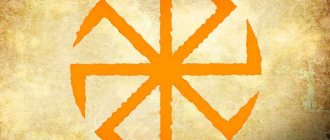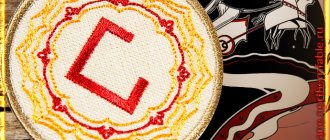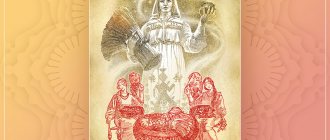Isis was the Egyptian Goddess of Magic. She was originally associated with the throne of Egypt, which had magical powers because it could turn a prince into a king.
Later, Isis “absorbed the attributes of most other goddesses and gods and became the supreme deity known for her healing and redemptive powers.
She was the sister and wife of Osiris. In Ancient Egypt, incest was considered normal in the lives of the Egyptian gods as it upheld the sacred bloodline of the divine image. The Egyptian goddess Isis was endowed with everything that the ancient Egyptians respected most in the female form. After her husband's death, she became the protector of the dead. In her love and devotion to Osiris, Isis became the symbol of a loving wife, and after he passed into the world of the dead, she became a symbol of the Mother in her protection and devotion to her only son Horus.
Everyone bowed before her kindness and gentleness, regardless of class: slaves and “sinners” prayed to her. She also supported nobles, rich people, and royalty. She was everyone's ally...
The goddess Isis personified fertility and love for everything around her. As the goddess of magic, she represented death, healing and birth. Isis used her magical knowledge and connection with nature to help others. She happened to become the first child of the God of the Earth - Geb, and the heavenly goddess Nut.
Archetype of Isis
The goddess Isis is depicted as a woman wearing a throne-shaped headdress. She is of Egyptian origin, but over time her cult spread throughout the Greco-Roman world.
The goddess of life, Isis, belongs to the category of great mother goddesses and is revered as the ideal consort. She is identified with fertility and is the protector of women, artisans, sinners and the oppressed.
The Goddess of Eternal Life, Isis represents the highest expression of the soulmate through the conscious use of feminine power, love and mysticism.
Isis - the most revered goddess of Ancient Egypt
In ancient Egypt, Isis was known as the goddess of fertility, wind, water and navigation. She was considered a symbol of marital fidelity and femininity. The Egyptians believed that if a wife cheated on her husband, Isis would definitely punish her. In addition, the named goddess was included in the list of deities who patronize medicine. In some descriptions she is also presented as the mistress of scorpions. In myths, Isis appears as the daughter of Geb and Nut, the great-granddaughter of Ra, as well as the sister and wife of Osiris.
The ancient Egyptians believed that this goddess gave people bees, created wedding dresses and taught women how to reap, weave and spin. In addition, she was the patroness of women in labor and determined the fate of newborn kings. It was believed that the goddess was present at the birth of the future ruler, helping the queen to relieve herself from pregnancy.
The Greeks and Romans called her “she who has a thousand names.” As for the meaning of the name of the goddess, it literally translates as “throne”. Isis personified the power of the pharaoh and was considered the heavenly mother of the current ruler, who provided him with the throne. It is interesting that Isis, like the Babylonian Ishtar, was originally an evil goddess, at enmity even with her son. But over time, she turns into a beneficent mistress, a loving wife and mother.
Mythology
Isis is the great goddess of motherhood and fertility in Egyptian mythology. Her cult originates from the Nile Delta. The goddess has numerous talents, but the main one is the manifestation of feminine power through will and compassion.
Isis was born in the swamps of the Nile on one of the first days of the creation of the world. She is the first daughter of Geb, the god of the earth, and Nut, the goddess of Heaven. Isis taught women to grind grain, weave flax, weave it, and tame men in family life. Isis lived with her brother Osiris, the god of the waters of the Nile and its flora. Upon reaching adulthood, they got married. Their union was happy and harmonious. The young devoted all their days to perceiving and managing the world. By joining forces, the gods sent grace to their native Egyptian land and to the fertile waters of the Nile. At night, the divine couple indulged in lovemaking, and nothing in this world could interfere with their union.
People worshiped and loved Osiris and Isis. Everyone except their jealous sibling Seth. He decided to overthrow their dominance. To do this, Set killed Osiris, hiding his body in a stone coffin. Subsequently, a large beautiful tree will grow from it. The goddess Isis was heartbroken after the news of her husband’s death. She cut her long beautiful hair and tore her clothes, mourning the loss of her husband. Searching for the body of her lover, Isis went to Phenicia, where Queen Astarte took her in out of pity. Thus, the goddess Isis became the nurse of the future prince at the royal court.
Isis looked after the child. But one day she put the boy in the furnace, where the angry queen found him. Isis revealed her magical abilities to her, and the future prince gained immortality that day. The Queen Mother, in turn, showed the goddess the place where there was a tamarind tree growing from the body of the god Osiris. Then Isis decided to bury her lover. Her brother Seth found out about this. He cut the body of Osiris into twelve pieces and scattered them throughout Egypt.
Birth of Isis: myth
In mythology, Isis is the daughter of Geb and Nut, the great-granddaughter of Ra, the twin sister of Osiris and his beloved wife. Almost all myths and tales about her are closely intertwined with tales about Osiris. In the mythology of various nationalities, the marriage of gods - brothers and sisters - was one of the indicators of their divine essence.
Surprisingly, the “Lady of Life” worshiped by the ancient Egyptians may not have been born due to an event that happened at the very dawn of time. At the time when Ra formed the world, his children - the god Shu (air) and the goddess Tefnut (water) - fell in love with each other, and from this beautiful love two gods were born - Geb (earth) and Nut (sky), who also fell in love arc friend.
The love was so strong that heaven and earth united! The sun, air, water froze, their movement stopped. Ra's rage knew no bounds; he ordered his son Shu to punish the disobedient lovers, because of this several catastrophic earthquakes occurred. But it was too late, Nut was already bearing five gods in her womb.
Among them were the Egyptian goddess Isis and Osiris. Enraged Ra determined that these children could not be born in any of the 12 months of the year. God Thoth came to the rescue; he exchanged five extra days from the Moon. They were located after twelve months. Nut gave birth to Isis on the fourth day.
Resurrection of Osiris
Isis, turning into a bird, flew over her native land in search of the remains of her husband. Having connected the found fragments with wax with the help of Anubis, she discovered the absence of a reproductive organ in the body of Osiris. Isis made a new instrument of love from gold and wax and completed the collection of the remains of her dead husband.
Subsequently, thanks to her magical powers, the goddess of life and health resurrected Osiris for a short period of time. This allowed her to conceive a son with him. The goddess gave the boy the name Horus. The child born wore the head of a falcon. He was born a strong and powerful god, who later took revenge on Seth for the death of his father.
This myth played an important role in Egyptian culture. It was believed that the flood of the Nile River were the tears that Isis shed for the dead Osiris.
The Legend of Osiris and Isis
This myth is known to many and its tragedy can touch the heart of anyone. Isis was the faithful wife of Osiris, but his brother killed him in order to take possession of his castle and power. And Osiris’s brother was so angry that he ordered his body to be cut into small pieces and not buried, so that people could not come to his grave to worship him. Isis wandered for a long time, but still collected her husband’s body and breathed life force into him for a moment to conceive a son.
The goddess managed to get pregnant, and she gave birth to a beautiful son, Horus, to whom she subsequently passed on all her magical knowledge. She loved him as she loved her husband, because he was his exact copy, his likeness. Probably because of such a tragic fate, Isis became the goddess of the hearth. Having lost her happiness, she helped others find it, supporting them in difficult moments of life.
Goddess Worship
Isis is considered one of the most famous and revered goddesses in the Mediterranean basin. From the Ptolemaic era, the worship of the goddess - a symbol of the bride, mother, fertility and patroness of sailors - spread to the Hellenistic world, and from there to Rome. It was there that the cult of the goddess acquired a mystical overtones. This is due to Isis’s connection with the other world.
At her birth in Egypt, the goddess received the name Au Set, which means “soul” in Egyptian. But the Greek colonialists, distorting the pronunciation, spread the cult of the worship of Isis from the Nile Delta to the banks of the Rhine. So the name of the goddess Isis (Isis) became known to the whole world.
During the development of the Roman Empire, the cult of the goddess of eternal life and health was expressed in magnificent celebrations and processions through the streets of cities. The priestesses of the goddess wore white clothes and decorated their hair with numerous flowers. This is where the cult of chastity comes from, because the color white is identified with purity and innocence.
In an older version, Osiris is identified with the Moon, and Isis with nature. Therefore, its colors have a green tint. But after the wedding, Isis became the wife of the moon god, which is why her colors changed to white.
A goddess who has conquered death in the hope of bringing back her lover is able to abolish it with equal ease for the followers of her faith.
How was Isis revered?
Since Isis was the patroness of women in labor, when a baby was born, those present offered prayers to her, and later brought gifts. This goddess was called upon in times of trouble, her name was spoken to protect children and family. The Book of the Dead contains hymns of Isis. The most common symbol of the goddess was the tet amulet, also known as the “Isis knot”. It was usually made from red minerals.
The oldest cult center of the goddess was discovered in the northern part of the Nile Delta, and more specifically in the city of Buto. Temples of Isis were located in many Egyptian cities, but she was most revered in Koptos, Abydos, Dendera and on the island of Philae. In the latter area, the goddess was revered until the 6th century AD. Back in the 4th century AD. The Roman Emperor Diocletian visited this place, hoping to find out the future. The famous religious building was destroyed by the Byzantine Emperor Justinian I.
Attributes of the goddess Isis
The Greek goddess of life was Mother Nature. She fought for the harmony of the world and tried to resist natural disasters. Two aspects were identified with Isis: the moon and nature. Her name is often interpreted as knowledge and wisdom. The innate ability to follow the nature of things is characterized as the inevitable mutual development of relationships. This is the wisdom of instinct that the goddess possessed.
Isis is often depicted holding a child in her arms. The baby is the result of the love of the goddess and the reincarnation of his beloved husband. During the period of mourning, the goddess of eternal life was dressed in black robes, like the black maiden from the shrine of Europe, the goddess of healing. The statues of black Isis also have another meaning. Like the shadow of the moon, in search of her missing husband, the goddess desperately yearns to be reunited with him.
The cult of Isis, centers of veneration and symbols
The cult of the fertility goddess Isis became widespread over time. She was revered everywhere: from all the lands of Ancient Egypt to the remote Roman provinces. Among the Greeks and Romans, the Egyptian goddess Isis, photos of whose images you can see in the article, was also a symbol and enjoyed universal attention. The Ptolemies of Egypt built many temples in her honor. Thus, the sanctuary of Debod was built south of Aswan. And with the decline of the era of the pharaohs and the flourishing of the era of Rome, temples were built in Nubia. An example is the temple of Kalabsha (ancient - Talmis). But the most famous is the Temple of Isis, located on the island. Fillet (Pilak).
Pharaoh Nectanebo I from the XXX dynasty decided to build a majestic temple of the goddess Isis, which became the largest cult center of the goddess. The following pharaohs and emperors of Rome contributed in every possible way to the maintenance of this cult. The temple was closed during the spread of Christianity in 537, by order of Emperor Justinian. All the statues were transported to Constantinople, and the Hypostyle Hall was converted into a Christian church, which once again confirmed its connection with the Mother of God.
The famous veil of Isis
The colorful veil of Isis bears similarities to the famous veil of Maya from ancient Indian philosophy. It represents several forms of nature identified with the holy spirit.
The veil or veil of Isis is the form of an ever-changing element, whose beauty and tragedy constantly float before the human gaze. It includes images of trees, hills, sea, people and their emotions. A person can only contemplate this picture, but he is not able to change it. This is the law of life.
A mortal touched by the veil of the goddess of life and health Isis is rewarded with God's mercy and good fortune.
Gods of Egypt
The culture of Egypt is one of the most diverse and ancient in the world. Egyptian mythology reflects and intertwines the cultural traditions and history of this state, its rapid ups and downs. The main role in legends and myths is, of course, played by the religious worldview and its basic postulates.
The pantheon of ancient Egyptian gods is very extensive. Its ranks number in total about 700 different divine beings, most of which were revered only in certain areas and were completely unknown in the rest of the territory. Of course, there were gods who were revered throughout the entire state. Almost all of them were represented by male creatures. The goddess Isis is a rare exception to the traditional rule.
Iconography
The goddess of life and health in ancient Greek mythology is often identified with a cow, between whose horns the sun is enclosed, and is also represented as a hawk or a woman with wings symbolizing the wind. In its winged form it can be seen on the lids of sarcophagi.
The image represents the act of the soul accepting new life. On other icons she appears as a clothed woman holding a lotus flower in her hands - a symbol of fertility and power, and also as a woman breastfeeding her newborn son. Sometimes the symbol of the goddess of eternal life Isis is the Egyptian oru knot. The exact meaning of this piece of clothing is unknown, but there is an assumption that it identifies immortality.
Symbols of Isis
The main symbol of the goddess described is the royal throne. His sign is quite often located on her head. The sacred animal of Isis was the great white cow of Heliopolis, who was the mother of the sacred Apis.
A widely used symbol of Isis is the Tet amulet, called the “Isis knot”. It is made from red minerals - jasper and carnelian.
The heavenly symbol of the goddess is Sirius. With the rise of this star, the Nile overflows from the tears of the goddess mourning her beloved husband.
Symbolism
In the rituals of celebrating Fertility Day, during the procession, a pot or cup filled to the brim with water was placed in front of the image of the god Osiris. This symbol denoted the eternal and unchanging change of generations. Also in primitive rituals one could see a torch, symbolizing a man, and a cup, symbolizing a woman, as a ritual for the conception of the heir of Osiris and Isis.
- Animals representing the Greek goddess of life were the hawk, scorpion, crocodile, and snake.
- Plants: tamarind, flax, wheat, barley, grapes, lotus.
- Metals and stones: silver, gold, ebony, ivory, lapis lazuli, obsidian.
- The colors of Isis are silver, gold, black, red, blue and green.
The role of the cult of Isis in history
Of course, the cult of Isis played a significant role in the history of the development of Egypt. And she was not only religious, but also social. For the first time, the feminine essence of the goddess in the person of Isis performed on an equal footing with men, and performed quite successfully. She was fair, cunning, wise, and had cosmic powers. Isis is a goddess who is worthy of worship. Negative aspects and human qualities are not alien to her, but her patronage is based on the ideals of goodness, as well as true family values. Ancient authors wrote a lot about it. Her cult greatly influenced the development of Christianity. It is to the image of Isis with Horus in her arms that the image of the Mother of God with her child goes back.
Her figurines were preserved as relics in several medieval churches.
Rituals of Isis
The main ritual of the goddess of life Isis was the revival of a lover from the world of the dead. It contained the hope of resurrection. In Ancient Egypt, a sacred ritual dedicated to this event was performed every year. It was one of the most important religious rites of the country.
Only people who had lost relatives and friends could take part in it. Guests of the ceremony observed the process of the rebirth of Osiris in the form of the son of Horus. The pain of loss was represented by the black robes of those present.
Source: fb.ru
religion
Misfortune of the Goddess
Despite the fact that Isis was a model of fidelity and love for her husband, Osiris did not have the same qualities. The moment he cheated on his wife with his sister Nephthys, the goddess of the other world, the offended Isis let out a cry of despair.
Soon she found little Anubis in the reed thickets. This was the child of Nephthys from Osiris, but his mother threw him away, fearing that the formidable Seth would find out about her betrayal. We must pay tribute to Isis, she took her nephew in to raise her, and the grown-up Anubis became the patron of the dead and their guide to the other world. In my opinion, Isis embodies a certain feminine and maternal ideal of that time, which, however, is still relevant today.
Despite the tricks of his wife, Seth became aware of the betrayal of Osiris. In addition, he himself was passionately in love with Isis, who did not notice anyone except her husband.
By cunning, Seth forced the king of the gods Osiris to lie down in a wonderful sarcophagus. Immediately the brother slammed the lid and threw the coffin into the Nile. Isis, who was endowed with charms from birth, realized that her lover was in trouble. Rejecting Set, who now took the throne of Osiris, she set out on a long search.
Finding dead Osiris in a Nile creek, she pulled the sarcophagus to the ground. Isis had excellent command of magic, and therefore could resurrect her husband. Here I would like to note that initially the goddess was the patroness of magical powers and all kinds of magical rituals, but only over time her functions expanded - she began to command air and moisture, fertility and vital energy.
The name of Isis in hieroglyphs
sida (Isis) (Egyptian js.t , ancient Greek Ἶσις , lat. Isis ) is one of the greatest goddesses of antiquity, who became a model for understanding the Egyptian ideal of femininity and motherhood. She was revered as the sister and wife of Osiris, the mother of Horus, and, accordingly, the Egyptian kings, who were originally considered the earthly incarnations of the falcon-headed god.
Origins of the cult
Being very ancient, the cult of Isis probably originated from the Nile Delta. Here was one of the most ancient cult centers of the goddess, Hebet, called by the Greeks Iseion (modern Behbeit el-Hagar), which currently lies in ruins. She was probably originally a local deity of Sebennite, but already the Pyramid Texts of the V Dynasty period indicate the key role of this goddess in the pan-Egyptian pantheon. Initially associated with the god Horus, due to the rise of the popular cult of Osiris, Isis is already the sister and wife of Osiris and the mother of Horus. Its original features were transferred to Hathor during the New Kingdom. In the Heliopolitan theological system, Isis, a minor deity of the Ennead, was revered as the daughter of the god Heb and the goddess Nut, respectively, as the great-granddaughter of Ra.
The Myth of Osiris and Isis
Isis
In myths, some of which have reached our time only in the famous retelling of Plutarch (“On Isis and Osiris”), the goddess is well known as the faithful wife of Osiris, whose body she found during his long wanderings after the god was killed by his brother Set. Having collected together the remains of Osiris, cut into pieces, Isis, with the help of the god Anubis, made the first mummy from them. Isis fashioned a phallus from clay (the only part of Osiris’s body that Isis could not find was the phallus: it was eaten by fish), consecrated it and attached it to the assembled body of Osiris. Having turned into a female kite - the Hat bird, Isis spread her wings over the mummy of Osiris, uttered magic words and became pregnant. In the Temple of Hathor in Dendera and the Temple of Osiris in Abydos, relief compositions have been preserved, which show the sacred act of conceiving a son by the goddess in the form of a falcon stretched over the mummy of her husband. In memory of this, Isis was often depicted in the guise of a beautiful woman with bird wings, with which she protects Osiris, the king, or simply the deceased. Isis often appears kneeling, wearing a white afnet bandage, mourning each deceased as she once mourned Osiris himself.
According to legend, Osiris became the lord of the underworld, while Isis gave birth to Horus in a nest of reeds in the marshes of Khemmis (Delta). Numerous statues and reliefs depict the goddess breastfeeding her son, who took the form of a pharaoh. Together with the goddesses Nut, Tefnut and Nephthys, Isis, bearing the epithet “Beautiful”, is present at the birth of each pharaoh, helping the queen-mother to be relieved of her burden. Isis - “great with charms, first among the gods,” mistress of spells and secret prayers; she is called upon in times of trouble, her name is spoken to protect children and families. According to legend, in order to acquire secret knowledge and gain magical power, the goddess fashioned a serpent from the saliva of the aging god Ra and the earth, which stung the solar deity. In exchange for healing, Isis demanded that Ra tell her his secret name, the key to all the mysterious powers of the universe, and became “the mistress of the gods, the one who knows Ra in his own name.”
With her knowledge, Isis, one of the patron deities of medicine, healed the infant Horus, who was stung by scorpions in the swamps. Since then, like the goddess Selket, she has sometimes been revered as the great mistress of scorpions. The goddess transferred her secret powers to Horus, thereby arming him with great magical power. With the help of cunning, Isis helped Horus defeat Set during the dispute over the throne and inheritance of Osiris and become the ruler of Egypt.
The Myth of Ra and Isis
Isis. Painted relief from the tomb of Seti I in the Valley of the Kings. XIX dynasty.
Isis, having become known among people as a sorceress, decided to test her powers on the gods. In order to become the mistress of heaven, she decided to find out the secret name of Ra. She noticed that Ra had become old by that time, saliva was dripping from the corners of his lips and falling to the ground. She collected drops of Ra's saliva, mixed it with dust, molded it into a snake, cast her spells over it and placed it on the road along which the solar god passed every day. After some time, the snake bit Ra, he screamed terribly, and all the gods rushed to his aid. Ra said that despite all his spells and his secret name, he was bitten by a snake. Isis promised him that she would heal him, but he must tell his secret name. The sun god said that he was Khepri in the morning, Ra at noon and Atum in the evening, but this did not satisfy Isis. And then Ra said: “Let Isis search in me, and my name will pass from my body to hers.” After this, Ra disappeared from the sight of the gods on his boat, and the throne in the Boat of the Lord of Millions of Years became free. Isis agreed with Horus that Ra must swear that he would part with his two Eyes (Sun and Moon). When Ra agreed that his secret name should become the property of the sorceress, and his heart taken out of his chest, Isis said: “Flowing poison, come out of Ra, Eye of Horus, come out of Ra and shine on his lips. It is I, Isis, who conjure, and it is I who made the poison fall to the ground. Truly the name of the great god is taken from him, Ra will live, and poison will die; if the poison lives, then Ra will die.”
Symbols
The symbol of Isis was the royal throne, the symbol of which is often placed on the goddess's head. Since the era of the New Kingdom, the cult of the goddess began to be closely intertwined with the cult of Hathor, as a result of which Isis sometimes wears a dress in the form of a solar disk framed by the horns of a cow. The sacred animal of Isis as a mother goddess was considered the “great white cow of Heliopolis” - the mother of the Memphis bull Apis.
One of the widespread symbols of the goddess is the tet amulet - the “knot of Isis”, or “the blood of Isis”, often made from red minerals - carnelian and jasper. Like Hathor, Isis commands gold, which was considered a model of incorruptibility; on the sign of this metal she is often depicted kneeling. The heavenly manifestations of Isis are, first of all, the star Sepedet, or Sirius, “the lady of the stars,” with the rise of which the Nile overflows from one tear of the goddess; as well as the formidable hippopotamus Isis Hesamut (Isis, the terrible mother) in the guise of the constellation Ursa Major, keeping the leg of the dismembered Seth in the heavens with the help of her companions - crocodiles. Also, Isis, together with Nephthys, can appear in the guise of gazelles guarding the horizon of the heavens; The emblem in the form of two gazelle goddesses was worn on tiaras by the younger wives of the pharaoh in the era of the New Kingdom. Another incarnation of Isis is the goddess Shentait, appearing in the guise of a cow, the patroness of funeral shrouds and weaving, the mistress of the sacred sarcophagus, in which, according to the Osiric ritual of the mysteries, the body of the murdered brother of Osiris is reborn. The direction of the world commanded by the goddess is the west, her ritual objects are the sistrum and the sacred vessel for milk is the situla. Together with Nephthys, Neith and Selket, Isis was the great patroness of the deceased, with her divine wings she protected the western part of the sarcophagi, and commanded the anthropomorphic spirit Imseti, one of the four “sons of Horus”, the patrons of the canopics.
Worship Centers
Terracotta statue of Isis mourning Osiris. XVIII dynasty. Louvre, Paris
The famous sanctuary of Isis, which existed until the disappearance of the ancient Egyptian civilization, is located on the island of Philae, near Aswan. Here the goddess, who was revered in many other temples of Nubia, was worshiped until the 6th century AD. e., at a time when the rest of Egypt had already been Christianized. The sanctuary of Isis and Osiris at Philae remained outside the scope of the edict of Emperor Theodosius I banning pagan cults in 391 due to an agreement reached by Diocletian with the rulers of Nobatia, who visited the temple at Philae as an oracle. Finally, the Byzantine Emperor Justinian I sent the military leader Narses to destroy the religious buildings on the island and bring their relics to Constantinople.
Other centers of veneration of the goddess were located throughout Egypt; the most famous of them are Koptos, where Isis was considered the wife of the god Min, lord of the eastern desert; Dendera, where the sky goddess Nut gave birth to Isis, and, of course, Abydos, in whose sacred triad the goddess was included along with Osiris and Horus.
Gnostic hymn associated by some scholars with Isis
May there never be anyone who does not know me anywhere and ever! Beware, don't be ignorant of me! For I am the first and the last. I am revered and despised. I am a harlot and a saint. I am a wife and a virgin. I am mother and daughter. I am the members of my mother's body. I am barren, and there are many of her sons. I am the one whose marriages are many, and I have not been married. I am the one who facilitates childbirth and the one who did not give birth. I am a consolation in my labor pains. I am newlywed and newlywed. And my husband is the one who gave birth to me. I am my father's mother and my husband's sister, and he is my offspring.
(Thunder. Perfect Mind. Hymn from the Nag Hammadi library, I-III centuries AD)
Isis in the ancient tradition
Temple of Isis in Pompeii
The goddess was well known to the Greeks and Romans. Wife of Osiris. She was identified with Demeter. She invented sails while searching for her son Harpocrates (Horus).
Identified with Io, daughter of Inachus, the Egyptians called Io that way.
Some believe that she became the constellation Virgo. Placed Sirius on the Dog's head. The fish that helped her became the constellation Southern Pisces, and her sons became Pisces.
The famous work of the ancient author Apuleius “Metamorphoses” describes initiation ceremonies into servants of the goddess, although their full symbolic content remains a mystery.
The cult of Isis and the mysteries associated with it became widespread in the Greco-Roman world, comparable to Christianity and Mithraism. As the universal mother goddess, Isis enjoyed wide popularity during the Hellenistic era, not only in Egypt, where her cult and sacraments flourished in Alexandria, but throughout the Mediterranean. Its temples (lat. Iseum) in Byblos, Athens, Rome are well known; The temple discovered in Pompeii is well preserved. Alabaster statue of Isis from the 3rd century BC. BC, discovered in Ohrid, is depicted on the Macedonian 10-denar banknote. In late antiquity, the sanctuaries and mysteries of Isis were widespread in other cities of the Roman Empire, among which the temple in Lutetia (modern Paris) stood out. In Roman times, Isis far surpassed the cult of Osiris in popularity and became a serious rival to the development of early Christianity. Caligula, Vespasian and Titus Flavius Vespasian made generous offerings to the sanctuary of Isis in Rome. In one of the images on Trajan's triumphal arch in Rome, the emperor is shown donating wine to Isis and Horus. Emperor Galerius considered Isis his patroness.
Some authors of the 19th and 20th centuries saw echoes of the cult of Isis in the veneration of the “Black Madonnas” in Christian churches of medieval France and Germany. There was also an opinion about the iconographic influence of the image of Isis with the baby Horus-Harmachis on the image of the Virgin Mary with the baby Jesus, as well as parallels between the motif of the flight of the Holy Family to Egypt from the persecution of Herod and the plot of how Isis hid young Horus in the reeds, fearing the wrath of Seth.
According to the famous ethnographer and religious scholar James Frazer, elements of the cult of Isis had a significant influence on Christian ritual:
The majestic ritual of Isis - these priests with tonsures, morning and evening services, bell ringing, baptism, sprinkling with holy water, solemn processions and jewelry images of the Mother of God <...> - in many respects resembles the magnificent ritualism of Catholicism.
However, a number of similarities mentioned by Frazer are controversial. For example, Frazer mentions the tonsures of the priests of Isis, although, according to Plutarch, the priests of Isis completely removed hair from the head and body.
Sources
- Website "Wikipedia - Free Encyclopedia"











